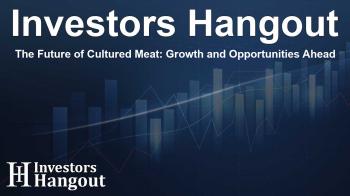The Future of Cultured Meat: Growth and Opportunities Ahead

Understanding the Cultured Meat Market's Growth
The cultured meat market is on a strong upward trajectory, with projections indicating a revenue of USD 538.48 million by 2031. This forecast, highlighted by recent research, indicates a remarkable compound annual growth rate (CAGR) of 17.15% from 2024 to 2031. In 2023 alone, the market was valued at USD 169.48 million, reflecting a significant shift in consumer preferences toward more sustainable and ethically produced food options.
The Drive Behind Cultured Meat
As more consumers embrace the idea of sustainable eating, cultured meat has emerged as a compelling alternative to traditional meat. It addresses concerns about animal welfare and environmental sustainability while also leveraging advanced biotechnology. However, challenges in scalability and cost reduction continue to be critical hurdles that the industry faces. Addressing these challenges is pivotal as manufacturers transition from pilot programs to full-scale commercialization.
Market Dynamics and Innovations
Technological advancements play a crucial role in the growth of the cultured meat industry. Innovations in cellular agriculture, including improved scaffold materials and optimized growth conditions, are enhancing efficiency in producing cultured meat. These developments not only improve yield quality but also contribute to lowering production costs, making cultured meat a more feasible option for wider consumer bases. Moreover, increasing investments from various sectors, such as venture capitalists and established food companies, signify a growing confidence in the cultured meat market's potential. Strategic partnerships are being formed to leverage existing distribution networks and brand credibility, facilitating quicker entry into the market.
Challenges Facing the Cultured Meat Industry
Despite the promising outlook, the cultured meat sector is not without its challenges. For starters, high production costs remain a significant barrier to mass-market penetration. Cultured meat production requires sophisticated technology and materials, all of which contribute to higher costs compared to conventional meat options. Without substantial cost reductions, businesses may struggle to expand beyond niche markets.
Regulatory Issues and Consumer Acceptance
The regulatory landscape for cultured meat is still evolving. While Singapore has legalized the sale of cultured meat, major markets like the U.S., EU, and China are in different stages of regulatory approval processes. This creates uncertainty that can delay commercialization and complicate market entry. Furthermore, gaining consumer acceptance is crucial; many potential customers harbor doubts about the safety and naturalness of lab-grown meat. Effective consumer education and transparency in production processes will be essential for overcoming these hurdles.
The Global Landscape of Cultured Meat
The cultured meat market is witnessing geographical dominance, particularly in North America, Europe, and the Asia-Pacific region. North America leads the charge, bolstered by significant investments in biotechnology and a supportive regulatory framework. Europe is not far behind, driven by a robust focus on sustainability, while Asia-Pacific, with its growing population and increasing food security concerns, presents substantial growth opportunities.
The Role of Key Players
Major companies are actively engaged in this burgeoning market. Industry leaders such as Eat Just, Inc., Mosa Meat, and Upside Foods are at the forefront, driving innovation and consumer acceptance. Their efforts are crucial in shaping the future of cultured meat and ensuring its expansion across global markets.
Conclusion: A Transformative Food Source
In conclusion, the cultured meat market is poised for substantial growth, underpinned by technological innovations and evolving consumer attitudes toward food sources. The increasing emphasis on sustainability and ethical consumption aligns perfectly with the promises of cultured meat. As challenges are addressed and innovations continue, we can expect to see a significant shift in how meat is produced and consumed globally.
Frequently Asked Questions
What is the projected market size for cultured meat by 2031?
The cultured meat market is expected to generate a revenue of USD 538.48 million by 2031.
What are the main drivers of growth in the cultured meat market?
Key drivers include rising demand for sustainable food sources, technological advancements in cellular agriculture, and increasing investments from major companies.
What challenges does the cultured meat industry face?
Challenges include high production costs, regulatory uncertainties, and consumer acceptance issues.
Which regions are leading in the cultured meat market?
The North American, European, and Asia-Pacific regions are currently leading in cultured meat market growth.
Who are the major players in the cultured meat market?
Major players include Eat Just, Inc., Mosa Meat, and Upside Foods among others, driving innovation in this sector.
About The Author
Contact Ryan Hughes privately here. Or send an email with ATTN: Ryan Hughes as the subject to contact@investorshangout.com.
About Investors Hangout
Investors Hangout is a leading online stock forum for financial discussion and learning, offering a wide range of free tools and resources. It draws in traders of all levels, who exchange market knowledge, investigate trading tactics, and keep an eye on industry developments in real time. Featuring financial articles, stock message boards, quotes, charts, company profiles, and live news updates. Through cooperative learning and a wealth of informational resources, it helps users from novices creating their first portfolios to experts honing their techniques. Join Investors Hangout today: https://investorshangout.com/
The content of this article is based on factual, publicly available information and does not represent legal, financial, or investment advice. Investors Hangout does not offer financial advice, and the author is not a licensed financial advisor. Consult a qualified advisor before making any financial or investment decisions based on this article. This article should not be considered advice to purchase, sell, or hold any securities or other investments. If any of the material provided here is inaccurate, please contact us for corrections.

